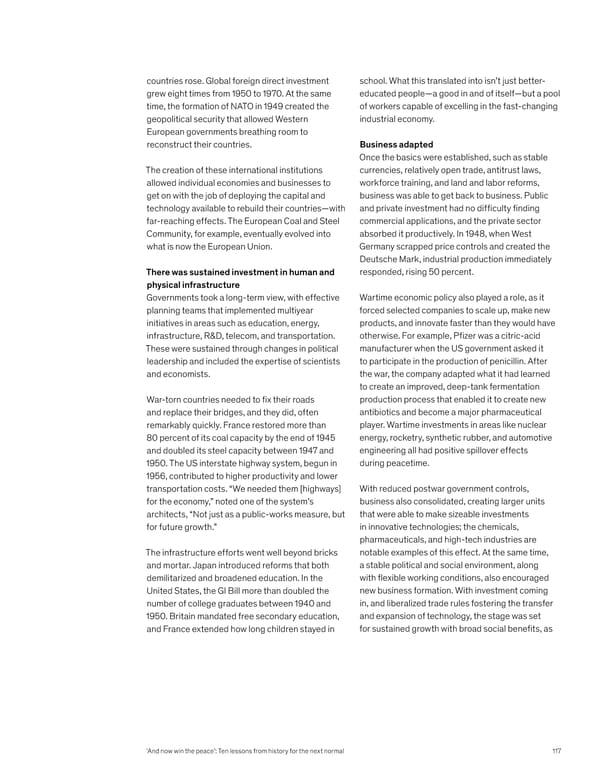countries rose. Global foreign direct investment school. What this translated into isn’t just better- grew eight times from 1950 to 1970. At the same educated people—a good in and of itself—but a pool time, the formation of NATO in 1949 created the of workers capable of excelling in the fast-changing geopolitical security that allowed Western industrial economy. European governments breathing room to reconstruct their countries. Business adapted Once the basics were established, such as stable The creation of these international institutions currencies, relatively open trade, antitrust laws, allowed individual economies and businesses to workforce training, and land and labor reforms, get on with the job of deploying the capital and business was able to get back to business. Public technology available to rebuild their countries—with and private investment had no difficulty finding far-reaching effects. The European Coal and Steel commercial applications, and the private sector Community, for example, eventually evolved into absorbed it productively. In 1948, when West what is now the European Union. Germany scrapped price controls and created the Deutsche Mark, industrial production immediately There was sustained investment in human and responded, rising 50 percent. physical infrastructure Governments took a long-term view, with effective Wartime economic policy also played a role, as it planning teams that implemented multiyear forced selected companies to scale up, make new initiatives in areas such as education, energy, products, and innovate faster than they would have infrastructure, R&D, telecom, and transportation. otherwise. For example, Pfizer was a citric-acid These were sustained through changes in political manufacturer when the US government asked it leadership and included the expertise of scientists to participate in the production of penicillin. After and economists. the war, the company adapted what it had learned to create an improved, deep-tank fermentation War-torn countries needed to fix their roads production process that enabled it to create new and replace their bridges, and they did, often antibiotics and become a major pharmaceutical remarkably quickly. France restored more than player. Wartime investments in areas like nuclear 80 percent of its coal capacity by the end of 1945 energy, rocketry, synthetic rubber, and automotive and doubled its steel capacity between 1947 and engineering all had positive spillover effects 1950. The US interstate highway system, begun in during peacetime. 1956, contributed to higher productivity and lower transportation costs. “We needed them [highways] With reduced postwar government controls, for the economy,” noted one of the system’s business also consolidated, creating larger units architects, “Not just as a public-works measure, but that were able to make sizeable investments for future growth.” in innovative technologies; the chemicals, pharmaceuticals, and high-tech industries are The infrastructure efforts went well beyond bricks notable examples of this effect. At the same time, and mortar. Japan introduced reforms that both a stable political and social environment, along demilitarized and broadened education. In the with flexible working conditions, also encouraged United States, the GI Bill more than doubled the new business formation. With investment coming number of college graduates between 1940 and in, and liberalized trade rules fostering the transfer 1950. Britain mandated free secondary education, and expansion of technology, the stage was set and France extended how long children stayed in for sustained growth with broad social benefits, as ‘And now win the peace’: Ten lessons from history for the next normal 117
 What Now? Page 118 Page 120
What Now? Page 118 Page 120